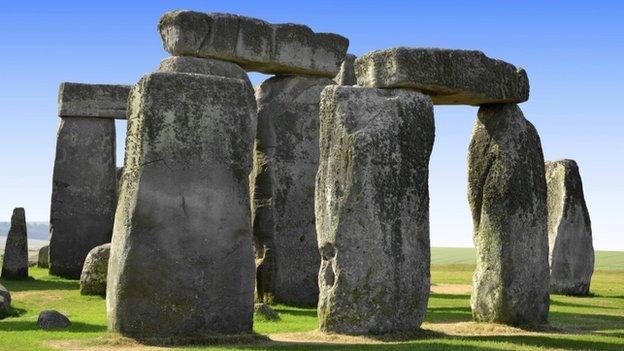Stonehenge's tallest stone 'points at winter sunrise'
- Published

The newly observed alignment (red line) is at 80 degrees to the line of the axis of the monument (blue line)
The tallest stone at Stonehenge points towards the sunrise on the midwinter solstice, according to a new theory from a steward at the site.
Historians have long known the circle of stones is aligned with the midsummer sunrise but Tim Daw says the tallest one is lined up with the midwinter sun.
It was previously thought the stone had been put back at the wrong angle when it was re-erected in 1901.
But Mr Daw, who works there, says his research shows its angle is deliberate.
'Botched job'
Mr Daw said: "The largest stone at Stonehenge is not where it 'should' be, it is twisted.
"This stone, Stone 56, is the tallest one at the end of the inner horseshoe of sarsen stones.
"Because it was put back to the vertical in 1901 it has been assumed that the twist is the result of the modern excavators botching the job.

The tallest stone in the monument was straightened in 1901
"My research shows that not only was the standing stone out of symmetry with the central solstice alignment originally, but that its now fallen partner had also been, and so were surrounding stones, including the Altar Stone."
Mr Daw, who last year came up with evidence that the outer stone circle at Stonehenge was once complete, said his newly discovered alignment was at 80 degrees to the line of the axis of the monument, which points to midsummer solstice sunrise and midwinter sunset.
'100 tonnes of stone'
"The stones point to the midwinter solstice sunrise and midsummer sunset," he said.
"This alignment had been missed by previous investigators... as they used an idealised plan rather than an actual plan for their calculations."
"This isn't some nebulous sighting line on a distant star; this is 100 tonnes of stone deliberately pointing to the major event at the other end of the day the rest of the monument celebrates.
"One stone out of line might be a coincidence but that it is five of the major stones, at least, shows it was a designed feature.
"It shows what can be discovered by simple observation even in such a well-researched site as Stonehenge."

Tim Daw said the tallest stone (centre) was positioned to align with the midwinter sunrise
Director of the Wiltshire Archaeological and Natural History Society (WANHS), David Dawson, said: "This is an interesting new idea which highlights the "skew" of the Stonehenge trilithons, which has been known for some time.
"It highlights the significance of the summer and winter solstices at Stonehenge, and the 80 degree angle between them.
"We know that the Bush Barrow lozenge, on display at the Wiltshire Museum, hints at this same significant astronomical feature.
"There will now be a debate between archaeologists and a re-examination of the evidence to test this new hypothesis."
Jessica Trethowan from English Heritage said it was "an interesting idea".
Mr Daw's theory has been published in the latest WANHS magazine.

People traditionally gather at Stonehenge for the winter and summer solstices
- Published14 November 2014

- Published20 September 2014

- Published30 August 2014
